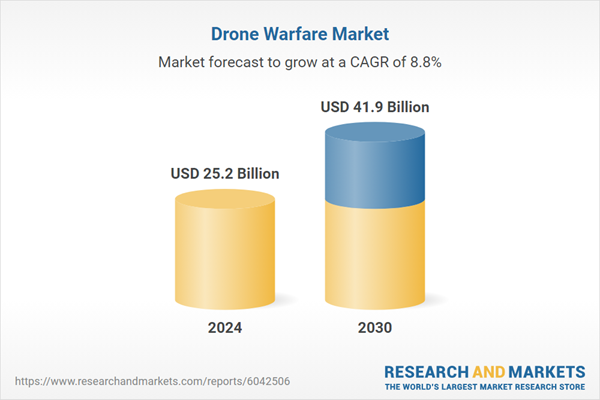Drone Warfare Global Strategic Research Report 2024-2030: Growing Emphasis on Swarm Technology, Lightweighting, Hypersonic Advancements, and AI-Enhanced Targeting
The Fixed Wing Drone Warfare segment is projected to reach US$20.5 Billion by 2030 with a 6.7% CAGR. The Hybrid Drone Warfare segment is expected to grow at a 13.7% CAGR over the analysis period. The U.S. market was valued at $6.6 Billion in 2024, while China is forecasted to reach $6.7 Billion by 2030 with an 8.6% CAGR. Growth trends in regions like Japan, Canada, Germany, and the Asia-Pacific are also noteworthy.

Dublin, March 19, 2025 (GLOBE NEWSWIRE) -- The "Drone Warfare - Global Strategic Business Report" report has been added to ResearchAndMarkets.com's offering. The global market for Drone Warfare was valued at US$25.2 Billion in 2024 and is projected to reach US$41.9 Billion by 2030, growing at a CAGR of 8.8% from 2024 to 2030.
This comprehensive report provides an in-depth analysis of market trends, drivers, and forecasts, helping you make informed business decisions. Drone warfare is fundamentally reshaping the landscape of modern military operations. Drones, particularly unmanned aerial vehicles (UAVs), have become critical tools in military arsenals, providing enhanced capabilities in intelligence gathering, surveillance, and precision strikes. These advanced systems offer the ability to conduct operations without the direct involvement of human pilots, minimizing risk while maximizing effectiveness.
What's Driving the Growth of the Drone Warfare Market?
The growth of the Drone Warfare market is driven by several interconnected factors, all of which are rooted in the increasing sophistication of military technology and the evolving nature of global conflict. The demand for cost-effective, low-risk, high-precision military operations is perhaps the most influential driver of market growth. Drones enable militaries to conduct operations with a much lower operational cost compared to manned aircraft, while also reducing the risk to human life.
Another significant factor driving the market is the increasing need for militaries to maintain an edge in modern, technology-driven warfare. As adversaries around the world invest in advanced defense systems, including anti-aircraft technologies and electronic warfare capabilities, drones are becoming essential for overcoming these challenges. Drones with stealth capabilities, AI-powered decision-making, and advanced countermeasures are becoming vital assets for maintaining a technological advantage in contested airspaces and high-risk regions.
Additionally, the growing use of drones in unconventional warfare, such as counterinsurgency operations and anti-terrorism missions, is a major contributor to market growth. Drones provide an unparalleled ability to target insurgent forces or terrorist cells with precision, often in environments where traditional military tactics would be less effective. As military forces continue to adopt drones for these types of operations, demand for more advanced and specialized drone systems will continue to rise.
Lastly, the increasing integration of drones into larger military systems is creating new opportunities for growth. Drones are no longer used in isolation but are part of a larger network of unmanned systems, from ground robots to naval assets, working together in a coordinated manner. This shift toward networked, multi-domain operations is enhancing the capabilities of drones, making them an integral part of modern military strategies and driving further demand in the market.
How are Technological Advancements Shaping the Future of Drone Warfare?
The evolution of drone warfare is closely linked to technological advancements, particularly in the areas of AI, stealth technology, and data analysis. AI is playing an increasingly important role in making drones more autonomous, allowing them to perform a wider range of tasks without direct human control. AI algorithms enable drones to process vast amounts of real-time data, such as battlefield imagery, weather patterns, and enemy movements, and use this information to make split-second decisions.
This enhances the effectiveness of drone operations by allowing them to adapt to dynamic combat environments and respond to threats more efficiently. In addition, the continued development of stealth technology is making drones harder to detect, especially in contested airspaces. Drones equipped with low radar cross-sections (RCS) and advanced countermeasures can evade enemy detection systems, giving them a tactical advantage in high-threat areas.
The integration of drones into networked systems is also transforming the nature of modern warfare. Drones no longer operate as isolated units but are increasingly part of broader, interconnected military networks. This includes collaboration with other unmanned systems, such as ground-based robots, naval drones, and satellite surveillance platforms. The ability for drones to share data and communicate with other assets on the battlefield creates a more cohesive and efficient military strategy, improving the overall effectiveness of operations.
These technological advancements are pushing the boundaries of what drones can achieve, allowing for more complex and precise military strategies.

